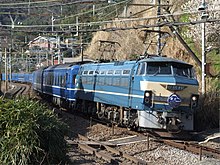JNR class EF66
| JR EF66 | |
|---|---|
|
EF66 11 in the Ōmiya depot
|
|
| Numbering: | EF66 901 (first EF90 1) EF66 1 - EF66 55 EF66 101 - EF66 133 |
| Number: | EF66 900: 1 EF66: 55 EF66-100: 33 |
| Manufacturer: | Kawasaki |
| Year of construction (s): | EF66 901: 1966 EF66 1-20: 1968-1969 EF66 21-55: 1973-1974 EF66-100: 1989-1991 |
| Axis formula : | Bo'Bo'Bo ' |
| Genre : | heavy freight train electric locomotive |
| Gauge : | 1067 mm ( cape track ) |
| Length: | 18,200 mm |
| Height: | 4200 mm |
| Width: | 2800 mm |
| Service mass: | 101 t |
| Wheel set mass : | 17 t |
| Top speed: | 120 km / h |
| Continuous output : | 3,900 kW (5,230 hp) |
| Performance indicator: | 38.6 kW / t |
| Driving wheel diameter: | 1120 mm |
| Power system : | 1.5 kV = |
| Number of traction motors: | 6th |
| Drive: | Hollow shaft drive |
The electric locomotives of the EF66 series ( Japanese EF66 形 電 気 機関 車 , EF66-gata denki kikansha ) are heavy freight locomotives of Japan Railways (JR) .
history
Until the 1950s, the JNR only knew wagonload traffic , which led to long transport times due to the dismantling and assembly of freight trains in the marshalling yards . In order to accelerate the transport of goods between was in November 1959 Tokyo and Osaka the combined transport with container - Block Train Takara (German "treasure") introduced the h with 85 km / speed connected the two destinations. The train was so successful that the JNR soon tried to increase its top speed to 100 km / h, so that from October 1, 1966, the train ran with new container wagons suitable for the higher speed and two EF65 locomotives at the top. In order to eliminate the uneconomical double traction , the JNR was looking for a more powerful locomotive that could pull a 1000-ton train at 100 km / h.
Kawasaki delivered the prototype EF90 1 with an output of 3.9 MW in September 1966, which was designed for the task. At that time it was the most powerful narrow-gauge locomotive in the world. In contrast to the box-shaped superstructures of the predecessor locomotives, the EF90 1 had a streamlined head shape for the first time.
In 1968 and 1969, the first 20 locomotives of the type newly designated as JNR class EF66 were delivered, which initially had a blue and white paint job. The EF90 1 was adapted to the series and renamed as EF66 901. After delivery, they were all assigned to the Shimonoseki depot , where they were used for fast freight traffic on the Tōkaidō main line and the San'yō main line .
In 1973 and 1974 another 34 locomotives were built, so that in total 56 locomotives were available. The locomotives of this second series differ from the first in that they have a sun visor over the windshield, which also has the task of keeping the contact line grease thrown off by the pantographs away from the windshield. The EF66 were used for slower freight trains, from 1985 they were used before heavy express trains because of the decline in freight traffic .
With the division and privatization of JNR in 1987, the locomotives EF66 1 - EF66 39 and EF66 901 came to JR Freight and the EF66 40 - EF66 55 JR West for passenger traffic, of which between 1999 and 2002 the numbers 41, 44, 52 and 54 were handed over to JR Freight.
From 1989 to 1991 another 33 locomotives were put into service in a slightly modified variant as the EF66-100.
The first locomotives were retired in 2001, at that time there were still 68 locomotives in service. At JR West, all locomotives were taken out of service in March 2009.
technology
The six-axle locomotive has three two-axle bogies . The middle bogie has mechanical balancing levers and air suspension that allow the bogie to move sideways. The motors drive the axles with a hollow shaft drive with a single-stage gearbox. The gear ratio is 20:71. The contact line voltage of 1500 V direct current is fed to the motors via adjustable series resistors . By regrouping the motors and field weakening operation , economical continuous speed levels are achieved.
The Spanish RENFE series 251 was derived from the EF66 .
Whereabouts

The EF66 11 is preserved in the Saitama Railway Museum. The two driver's cabs of the locomotives EF66 45 and EF66 49 have also been preserved.
EF 66 35, restored in new condition, is on display in the Kyoto Railway Museum (as of August 2017)
literature
- David Ross: The International Encyclopedia - Trains and Locomotives . 1st edition. transpress Verlag, Stuttgart 2005, ISBN 3-613-71266-0 , p. 450 .
Web links
Individual evidence
- ↑ a b c d e f g h The Railway Museum in Saitama: EF66. In: Japanese Steam Locomotives . Retrieved March 22, 2016 .
- ↑ Katsuhisa Fujii: 国 鉄 最大 最 強力 電機 EF66 形 の す べ て . All about Class EF66, the largest and the most powerful electric locomotive of JNR. In: Japan Railfan Magazine . Vol. 31, No. 367 . Koyusha Co. Ltd, Japan November 1991, p. 8th ff .
- ^ Renfe Series 251. In: Ferropedia . Retrieved March 22, 2016 (Spanish).


